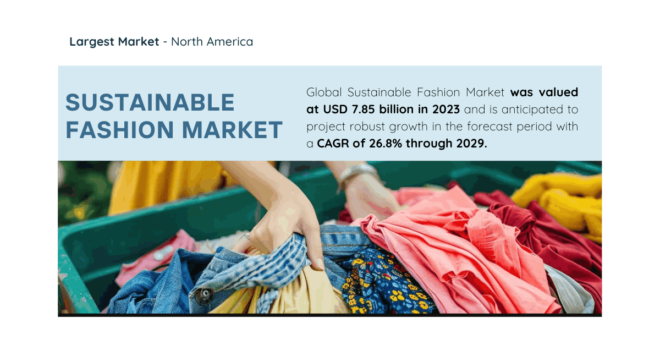
The sustainable fashion market, a growing segment of the global apparel industry, reflects a transformative shift in consumer preferences towards ethical and eco-friendly practices. According to TechSci Research, the global sustainable fashion market was valued at USD 7.85 billion in 2023 and is projected to grow at a CAGR of 26.8% through 2029.
This report examines the market’s driving forces, segmentation, key trends, and the roles of major players, outlining the promising future of sustainable fashion.
Sustainable Fashion Market Dynamics and Key Drivers
- Environmental Awareness
Traditional fashion production significantly impacts the environment through excessive water usage, chemical pollution, and carbon emissions. With growing awareness facilitated by documentaries, social media campaigns, and movements such as the Fashion Revolution, consumers are demanding sustainable alternatives. This has pushed brands to adopt eco-friendly practices and materials.
- Consumer Behavior Shifts
Modern consumers are increasingly choosing products that align with their ethical and environmental values. Younger generations, especially millennials and Gen Z, are leading this shift, advocating for greater transparency and ethical practices in the fashion supply chain.
Browse over XX market data Figures spread through XX Pages and an in-depth TOC on the “Global Sustainable Fashion Market” @ https://www.techsciresearch.com/report/sustainable-fashion-market/21170.html
- Circular Fashion
The rise of circular fashion has transformed how garments are produced, used, and discarded. Practices like clothing rental, resale, and repair are gaining popularity, encouraging longer garment life cycles and reducing waste. Companies such as Rent the Runway and ThredUp are spearheading this movement.
Key Segments of the Sustainable Fashion Market
Eco-Friendly Materials
Brands are increasingly adopting sustainable fabrics, including:
- Organic Cotton: Requires less water and avoids harmful pesticides.
- Hemp and Linen: Durable, biodegradable, and resource-efficient.
- Tencel: A cellulose-based material with low environmental impact.
- Recycled Polyester: Repurposes plastic waste into durable fibers.
Ethical Manufacturing Processes
Sustainable fashion emphasizes fair labor practices, ensuring safe working conditions and equitable wages. Ethical manufacturing is a significant factor in gaining consumer trust.
Transparent Supply Chains
Consumers are demanding greater insight into the origin and production of their purchases. Brands that embrace transparency enjoy stronger customer loyalty and market positioning.
Consumer Demographics and Influence
Generational Drivers
- Millennials and Gen Z: These groups are more informed about environmental issues and actively seek brands that reflect their values.
- Social Media Impact: Platforms like Instagram and TikTok play a crucial role in spreading awareness and showcasing sustainable fashion.
Regional Trends
- North America: Early adopters of sustainable fashion, driven by high consumer awareness.
- Europe: Regulatory frameworks and consumer advocacy boost demand.
- Asia-Pacific: Rising interest due to the increasing influence of global trends and local initiatives.
Circular Fashion: A Paradigm Shift
Clothing Rental and Resale
Circular fashion promotes reusability, reducing waste and encouraging mindful consumption. Examples include:
- Rent the Runway: Enables clothing rentals for special occasions.
- ThredUp: Facilitates resale of second-hand garments.
Repair and Upcycling
Encouraging consumers to repair and upcycle their clothing extends product life, reducing the need for frequent purchases.
Role of Accessories in the Sustainable Fashion Market
Fastest-Growing Segment
Accessories have emerged as a key growth area for sustainable fashion due to their:
- Longer Lifespan: Often outlast clothing items, making them inherently more sustainable.
- Versatility: Allow consumers to incorporate sustainability into their wardrobes incrementally.
Innovative Materials
Sustainable accessory lines utilize materials like recycled metals, bio-based plastics, and upcycled textiles, appealing to environmentally-conscious consumers.
Technological Advancements
Innovative Materials
Advances in material science have led to the creation of bio-fabrics, lab-grown leather, and low-impact dyes, enhancing the sustainability of fashion.
Digital Tools
Technologies like blockchain enable traceability in supply chains, fostering greater transparency. Additionally, AI-driven design tools minimize waste during production.
Major Players in the Sustainable Fashion Market
Prominent companies reshaping the market include:
- H & M Hennes & Mauritz AB
- Industria de Diseño Textil, S.A. (Inditex, S.A.)
- Gap Inc.
- Guccio Gucci S.p.A.
- Nike, Inc.
- Adidas AG
- Levi Strauss & Co.
- VF Corporation
- FAST RETAILING CO., LTD. (Uniqlo)
- Prada S.p.A.
Sustainable Fashion Market Segmentation
By Type
- Clothing: Dominates the market but faces competition from accessories.
- Footwear: Rising demand for eco-friendly and durable designs.
- Accessories: Fastest-growing due to versatility and innovation.
By Fabric Type
- Organic and recycled materials dominate due to their minimal environmental impact.
By Distribution Channel
- Online Platforms: Increasingly popular for their convenience and ability to showcase transparent practices.
- Brick-and-Mortar Stores: Focused on delivering tangible proof of sustainability.
Opportunities and Challenges
Opportunities
- Growing Consumer Awareness: An expanding audience seeking eco-conscious alternatives.
- Collaborations and Advocacy: Partnerships between brands and non-profits raise awareness and drive innovation.
Download Free Sample Report @ https://www.techsciresearch.com/sample-report.aspx?cid=21170
Customers can also request 10% free customization on this report.
Challenges
- High Production Costs: Sustainable materials and ethical practices can be expensive.
- Scalability Issues: Small sustainable brands may struggle to meet growing demand.
Future Outlook of Sustainable Fashion Market
Projected Growth
The sustainable fashion market is anticipated to grow significantly, reaching new heights by 2029. This growth will be driven by continued consumer advocacy, technological advancements, and brand initiatives.
Collaboration and Innovation
Collaborations between mainstream and sustainable brands will enhance market visibility, while ongoing innovations in materials and practices will sustain growth.
Conclusion
The global sustainable fashion market represents a transformative evolution in the fashion industry, driven by increased consumer awareness and a commitment to ethical and environmental responsibility.
The rise of eco-friendly materials, ethical labor practices, and circular fashion models marks a new era where sustainability is at the forefront.
With its promising trajectory, the sustainable fashion market is not merely a trend but a fundamental shift towards a more conscious and responsible future for fashion.
You may also read:
Suitcase and Briefcase Market Report: Key Trends, Demand, and 5.79% Growth Forecast to {2029}
Sun Lounger Market {2029} Size to Surge with 5.7% CAGR, USD 2.95 Billion
Surface Water Sports Equipment Market to Reach USD [53.1 Billion] by {2029} with a CAGR of [9.4%]
